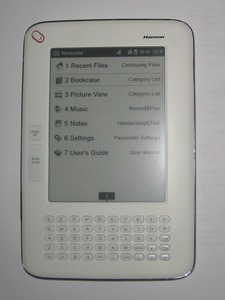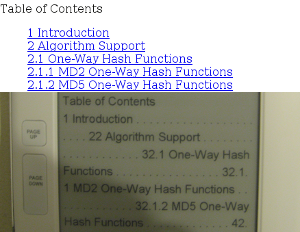Tuesday, January 26. 2010
Hanvon WISEreader N526 - hardware fine, software a desaster
 When asking me what I'd consider the most interesting technical developments in the near future, electronic books would be on the top of my list. So recently, I finally decided to buy one and ordered a Hanvon WISEreader N526. It has a pretty fair price, it seemed that free software support was likely to appear some time in the future (more on that later) and it has a touchscreen with pen, which was a feature I wanted to mark things in books.
When asking me what I'd consider the most interesting technical developments in the near future, electronic books would be on the top of my list. So recently, I finally decided to buy one and ordered a Hanvon WISEreader N526. It has a pretty fair price, it seemed that free software support was likely to appear some time in the future (more on that later) and it has a touchscreen with pen, which was a feature I wanted to mark things in books.From the hardware side, the device is pretty ok. Most ebook readers on the market share the same technologie for the display, it could have a bit more contrast, but else it's pretty okay. The device itself has a keyboard (which is querty, but not really ordered like a querty-keyboard), USB (not working as mass storage though), an audio output and a micro SD slot. Also, as said above, it has a touchscreen that can be used with a pen. So on the hardware side the device is quite fine.
What's not fine is the software running on it. It makes many features pretty much useless. Just to name a few flaws:
- Adding marks with the pen, one of the main features of the hardware, is pretty useless. It works neither on PDFs nor on epub files. It only works for TXT and HTML files, so it's not possible to do any marks on any layouted file format.
- HTML files are not supported. The vendor claims HTML support, but that's a plain lie. What it does is stripping out all HTML tags and showing the Text. If you know how HTML works, you can expect that this leads to pretty broken results and breaks all layout in HTML. Also, Hyperlinks don't work at all.
- The zooming capabilities are very limited. For text, you only have three zoom levels. All of them are far larger than normal text in a book. For PDF, it's possible to make it fit on height or width, but not anything in between.
- If you browse the files, there is no possibility to show the full filename, it only shows the beginning of the filename (about 20 characters). If you have files named “Author's name – Book title“ (which seems like a pretty common idea), you will only see some files with the author's name – not very useful.
- The device has a button for landscape view (turn the view 90°). But it doesn't work. Probably a bug.

Example for HTML “support“ compared with original
Another thing I'm looking at is OpenInkpot. It's a free firmware for ebook devices and they are working on support for the N526. However, having talked to the developers it seems that support for the touchscreen/pen is pretty unsure, as the vendor refuses to provide any documentation for that. Also, as this is a volunteers project, it's not clear if and when proper support will be available.
Thursday, January 14. 2010
BIOS update by extracting HD image from ISO
Today I faced an interesting Linux problem that made me learn a couple of things I'd like to share. At first, we found an issue on a Thinkpad X301 notebook that was fixed in a newer BIOS version. So we wanted to do a BIOS update. Lenovo provides BIOS updates either for Windows or as bootable ISO CD-images. But the device had no CD-drive and only Linux installed. First we tried unetbootin, a tool to create bootable USB sticks out of ISO-Images. That didn't work.
So I had a deeper look at the ISO. What puzzled me was that when mounting it as a loopback device, there were no files on it. After some research I learned that there are different ways to create bootable CDs and one of them is the El Torito extension. It places an image of a harddisk on the CD, when booting, the image is loaded into memory and an OS can be executed (this probably only works for quite simple OSes like DOS, the Lenovo BIOS Upgrade disk is based on PC-DOS). There's a small PERL-script called geteltorito that is able to extract such images from ISO files.
It's possible to boot such harddisk images with grub and memdisk (part of syslinux). Install syslinux, place the file memdisk into /boot (found in /usr/lib/syslinux/ or /usr/share/syslinux/) and add something like this to your grub config:
Or for grub2:
Now you can select bios update in your boot menu and it should boot the BIOS upgrade utility.
(Note that this does not work for all Lenovo BIOS updates, only for those using an El Torito harddisk image - you can mount your iso with mount -o loop [path_to_iso] [mount_path] to check, if there are any files, this method is not for you)
So I had a deeper look at the ISO. What puzzled me was that when mounting it as a loopback device, there were no files on it. After some research I learned that there are different ways to create bootable CDs and one of them is the El Torito extension. It places an image of a harddisk on the CD, when booting, the image is loaded into memory and an OS can be executed (this probably only works for quite simple OSes like DOS, the Lenovo BIOS Upgrade disk is based on PC-DOS). There's a small PERL-script called geteltorito that is able to extract such images from ISO files.
It's possible to boot such harddisk images with grub and memdisk (part of syslinux). Install syslinux, place the file memdisk into /boot (found in /usr/lib/syslinux/ or /usr/share/syslinux/) and add something like this to your grub config:
title HD Image
root (hd0,0)
kernel /boot/memdisk
initrd /boot/image.img
root (hd0,0)
kernel /boot/memdisk
initrd /boot/image.img
Or for grub2:
menuentry "HD Image" {
set root=(hd0,2)
linux16 /boot/memdisk
initrd16 /boot/hdimage.img
}
set root=(hd0,2)
linux16 /boot/memdisk
initrd16 /boot/hdimage.img
}
Now you can select bios update in your boot menu and it should boot the BIOS upgrade utility.
(Note that this does not work for all Lenovo BIOS updates, only for those using an El Torito harddisk image - you can mount your iso with mount -o loop [path_to_iso] [mount_path] to check, if there are any files, this method is not for you)
(Page 1 of 1, totaling 2 entries)